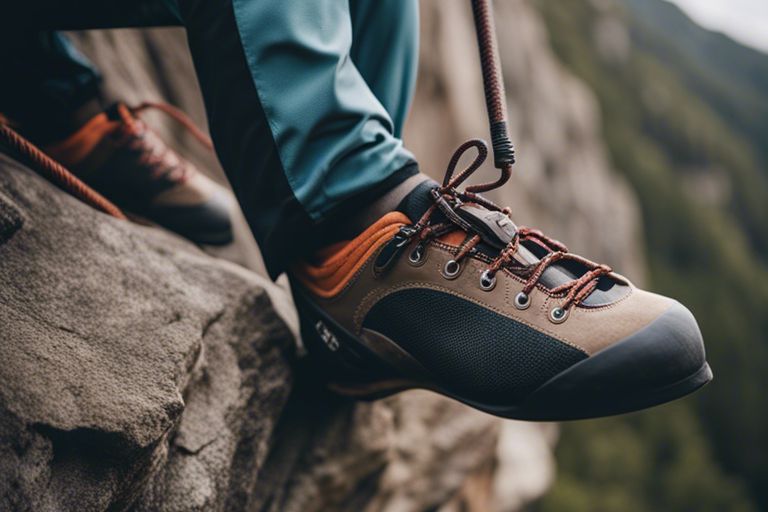There’s a critical point in every climber’s gear maintenance routine that can make the difference between life and death – knowing when to retire a climbing rope. As you initiate on your next adventure, it’s vital to understand the signs that indicate your trusty rope may no longer be safe for use. In this guide, we’ll walk you through the tell-tale indications that it’s time to bid farewell to your climbing companion and invest in a new one to keep you safe on the crag.
Key Takeaways:
- Inspect regularly: Regularly check your climbing rope for signs of wear and damage such as cuts, fraying, or soft spots.
- Retire if necessary: If your climbing rope shows significant wear or damage, it is important to retire it to ensure your safety while climbing.
- Follow manufacturer guidelines: Always follow the manufacturer’s guidelines on when to retire your climbing rope, as they may vary depending on the type and usage of the rope.
The Importance of Rope Inspection
To ensure your safety while climbing, it is crucial to regularly inspect your climbing rope for signs of wear and tear. By regularly inspecting your rope, you can catch potential issues before they become safety hazards, ultimately extending the lifespan of your gear and keeping you safe on the rocks.
Visual Inspection
One of the first steps in rope inspection is a visual check. Look for any fraying or cuts along the length of the rope, paying close attention to the ends where most of the wear tends to occur. Check for any changes in the diameter of the rope, as this could indicate core damage. Additionally, keep an eye out for any soft spots or inconsistencies in the texture of the rope, as these could be signs of internal damage.
Checking for Damage
For a more thorough inspection, run your fingers along the entire length of the rope, feeling for any flat or soft areas. These could indicate sheath slippage, which compromises the strength of the rope. Inspect the entire length of the rope for any hard or glazed sections, as these could be signs of heat damage from friction or harsh use. Bear in mind, any doubts about the integrity of your rope should lead to retiring it for a new one to ensure your safety.
Rope safety is paramount in climbing, and regular inspections are key to ensuring the reliability of your gear. By staying vigilant and conducting routine checks, you can climb confidently knowing your rope is in good condition, ready to support you on your next adventure.

Factors Affecting Rope Lifespan
Even though climbing ropes are designed to withstand significant wear and tear, several factors can affect their lifespan. It’s vital to be aware of these factors to determine when it’s time to retire your climbing rope.
Usage and Frequency
- Any sharp rock edges or repeated falls can lead to wear and damage on your climbing rope. The more you use your rope and the more falls it endures, the quicker it will wear out.
The care you take during your climbs, such as avoiding dragging the rope over rough surfaces and using proper belay techniques, can significantly impact your rope’s longevity.
Environmental Conditions
- One of the significant factors affecting the lifespan of your climbing rope is the environmental conditions it is exposed to. High levels of moisture, UV exposure, extreme temperatures, and chemicals can all degrade the fibers of your rope.
Plus, storing your rope properly when not in use is crucial for its longevity.
Storage and Maintenance
- On top of the environmental factors, how you store and maintain your climbing rope can also impact its lifespan. Proper storage away from direct sunlight, moisture, and chemicals is vital to keep your rope in good condition.
Understanding these factors and taking proper care of your climbing rope will ensure its longevity and keep you safe during your climbing adventures.
Signs of Wear and Tear
Now, let’s talk about the signs that indicate your climbing rope may need to be retired. There are a few key things to look out for when inspecting your rope for wear and tear.
Fraying and Abrasion
Abrasion can occur from rock surfaces, sharp edges, or even repeated use on rough terrain. Fraying is a common issue caused by abrasion, where the rope fibers start to separate and become fuzzy. If you notice fraying along the length of your rope or in specific spots, it’s a clear sign of wear and could compromise the strength of the rope.
Cuts and Snags
An unexpected cut or snag in your climbing rope can seriously jeopardize its integrity. Inspect your rope regularly for any visible cuts, slices, or snags. Even small nicks can weaken the rope significantly, so don’t take them lightly.
Another potential hazard is when your rope gets stuck in crevices or between rocks. The friction and pressure can cause the sheath to tear or the core strands to weaken, compromising the overall strength of the rope.
Discoloration and Fading
One common sign of UV damage and aging is discoloration and fading of your climbing rope. If you notice significant fading, especially in certain areas that are regularly exposed to sunlight, it’s a warning sign that the rope may have weakened over time.
Fading can be a result of both UV exposure and general wear from use. It’s important to pay attention to these visual cues as they can indicate that your rope is nearing the end of its safe lifespan.
Performance-Based Retirement Criteria
Reduced Strength and Elasticity
Not just any visible wear and tear on your climbing rope should signal retirement. Look out for signs of reduced strength and elasticity. As ropes age, the fibers can become weakened and lose their ability to absorb the energy from falls, increasing the risk of a catastrophic failure. If you notice a significant decrease in the rope’s diameter, core mushiness, or a soft feel when handling the rope, it may be time to retire it.
Increased Stretch and Sag
On the same note, any excessive stretch or sag in your climbing rope should also be a red flag. If your rope now sags more than usual or elongates significantly during a fall, it may have reached the end of its functional life. Increased stretch can compromise your safety, as it affects the rope’s ability to absorb the energy from a fall and can lead to higher impact forces on you. Don’t take the risk – retire a rope showing these signs.
Criteria
Unusual Behavior Under Load
Criteria to determine if your rope is exhibiting unusual behavior under load include looking for any kinks, lumps, or sections that feel stiff to the touch. These can be indicators of internal damage, such as sheath slippage or core damage, making the rope unsafe for further use. Additionally, if you notice the rope getting stuck while feeding it through a belay device or if the sheath is significantly frayed in specific areas, it is time to retire the rope to ensure your safety.
To make sure you stay safe while climbing, always keep a keen eye on these performance-based retirement criteria. Inspect your climbing rope regularly and be vigilant for any signs of reduced strength, increased stretch, or unusual behavior under load. Your life literally depends on it, so don’t take any chances with a worn-out rope.

Manufacturer Guidelines and Recommendations
Rated Lifespan and Usage Limits
Many climbing rope manufacturers provide guidelines on the rated lifespan and usage limits of their ropes. It’s important to follow these recommendations to ensure your safety while climbing. Any rope will have a maximum number of falls it can sustain before it needs to be retired. Additionally, the manufacturer will typically specify the maximum amount of weight the rope can safely support.
Inspection and Retirement Schedules
Inspection and retirement schedules are crucial to keeping yourself safe while climbing. It’s necessary to regularly inspect your climbing rope for signs of wear and damage. Any fraying, cuts, abrasions, or soft spots indicate that the rope may need to be retired. You should also create a retirement schedule based on how frequently you use the rope and the conditions in which you climb.
It’s a good practice to retire your climbing rope after a certain number of years, regardless of its appearance. Even if the rope looks fine, the materials could have degraded over time, compromising its strength and safety.
Certification and Compliance
Schedules for certification and compliance are set by climbing rope manufacturers to ensure their products meet safety standards. It’s crucial to check that your rope is certified and compliant with industry regulations. For instance, UIAA (International Climbing and Mountaineering Federation) and CE (Conformité Européenne) certifications are commonly seen on climbing ropes, indicating that they meet specific safety requirements.
For instance, a UIAA certification ensures that the rope has passed stringent safety tests, providing you with the assurance that it meets the highest standards for climbing safety.
Real-World Examples and Scenarios
Climbing Accidents and Near-Misses
Scenarios where climbing ropes have been put under extreme stress can be eye-opening. After a fall or accident, even if the rope appears undamaged, it’s important to assess its condition thoroughly. For instance, if the outer sheath shows significant abrasion or wear, it might be time to retire the rope.
Rope Failure and Consequences
Failure to retire a climbing rope at the right time can have serious consequences. One example is when a climber ignored visible signs of wear and continued to use a compromised rope, leading to a dangerous fall. Always prioritize safety over cost or convenience when deciding whether to retire your climbing rope.
Another aspect to consider is the impact of a rope failure on your climbing partner or others around you. If a rope breaks mid-climb due to overuse or damage, not only are you risking your own safety but also that of others who may be climbing with you or even below you.
Best Practices and Lessons Learned
To ensure your safety and the safety of others, it’s crucial to follow best practices regarding climbing rope retirement. Regularly inspect your rope for signs of wear, such as fuzzy spots, cuts, or soft spots. Additionally, keep a log of your rope’s usage and falls to track its history and make an informed decision on when to retire it.
For instance, if your rope has taken multiple big falls or has been used extensively in harsh environments, it’s better to err on the side of caution and replace it sooner rather than later. Recall, your climbing rope is a critical piece of safety equipment, and knowing when to retire it is key to preventing accidents and ensuring your continued enjoyment of the sport.
Conclusion
On the whole, knowing when to retire a climbing rope is crucial for your safety while climbing. It is important to regularly inspect your rope for any signs of wear and tear, and to follow the manufacturer’s guidelines for retirement. Recall, your climbing rope is a critical piece of equipment that can mean the difference between a successful climb and a dangerous fall. So make sure to prioritize safety by retiring your rope when it shows signs of damage or reaches its recommended lifespan.
By being proactive in caring for your climbing rope, you can ensure that it remains a reliable and safe tool for your climbing adventures. Don’t take any chances – when in doubt, retire your rope and invest in a new one to continue enjoying the thrill of climbing with peace of mind.
FAQ
Q: When should I retire my climbing rope?
A: You should retire your climbing rope when it shows signs of significant wear and tear, such as core shots, sheath fuzzing, or soft spots. It is recommended to retire your rope after 5 years of regular use, even if it still looks visually intact.
Q: How can I inspect my climbing rope for signs of wear?
A: You can inspect your climbing rope by running your fingers along the entire length to feel for any soft spots, flat areas, or bumps. Look for excessive fraying, cuts, or a fuzzy sheath. If you find any of these signs, it’s best to retire the rope.
Q: What are the potential risks of using a worn-out climbing rope?
A: Using a worn-out climbing rope can increase the risk of accidents and injuries while climbing. A compromised rope may not be able to hold falls or may snap unexpectedly, leading to dangerous situations. It’s crucial to replace a worn-out rope to ensure your safety.




